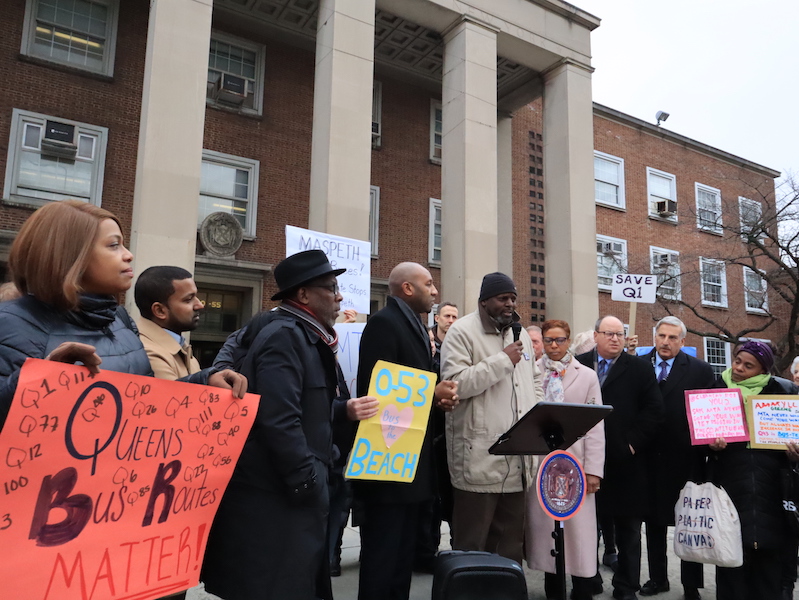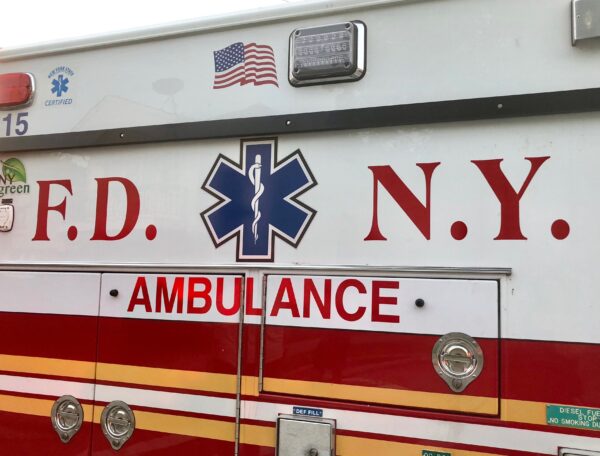
Queens, NY – The MTA spent months conducting informational meetings and surveys on how to improve bus service, but clearly didn’t take into account the opinions of the riders from the World’s Borough.
The Metropolitan Transit Authority’s bus redesign plan for the geographically largest borough and the second most populous is to eliminate bus routes that don’t go to directly to the subway or that seem redundant on the surface, and to utilize buses that do, but space the stops several blocks a part, according to politicians, community leaders and ATU Local 1056.
Some of the buses that are to be on the chopping block or absorbed into a new bus line include the Q23, Q1, Q46, Q49, Q10, Q53, Q43 and Q64.
These particular buses that were mentioned at a Friday rally outside Queens Borough Hall serve eastern Queens, a transit desert that is not close to subways, Far Rockaway, which is hard to reach, and central Queens where there is slow or infrequent bus service.
“Every pocket of Queens is against this plan,” said Councilman Donovan Richards (D-Far Rockaway, Jamaica). “It is simply because we see it for what it is. There was very little real community input.”
The MTA’s plan decreases service instead of speeding it up, according to Richards.
“Eddie Murphy called this the ‘Jedi mind-trick,'” said Richards, a candidate for the Queens Borough race. “They are going to cut service to speed it up! We have an obligation that we push back and that this plan is comprehensive and inclusive.”
The current bus design was based on trolley lines from the 1870s to the 1950s.
Bus lines in northern Queens cannot connect to southern Queens, according to Richards.
“This plan totally fails,” said Richards, who took public transit from the Rockaways to Jackson Heights to attend school. “You can get to Florida by plane faster than it took to get to Jackson Heights.”
Councilman I. Daneek Miller (D-St. Albans), a former bus driver and president of Local 1056, agreed.

“This is an opportunity to fix the system that is old, that is antiquated and totally suppressing Queens and making it an outerborough,” said Miller. “Transportation is the great equalizer if you want to grow a community, enhance its transportation options, conversely if you want to suppress a community you suppress their transportation options. That is what has happened for us for so long.”
You can’t fix the bus line without investing in it, according to Miller.
“We don’t want a consolidation disguised as a new system, we don’t want an alleged faster system,” said Miller. “We want a system that connects us that is safe, efficient and moves people to and from in a manner that they deserve and addresses all the needs of our communities.”
The current ATU Local 1056 President Mark Henry was disappointed in what the MTA proposed.
“Queens itself is a unique borough and it needs to be treated in a unique manner,” said Henry, “not pushed through a fast-forward plan that bypasses neighborhoods, churches, schools and places of interests to get around.”
One important place that has many interesting spots includes central Queens according to Miller.
“This is an opportunity to connect this borough,” said Miller. “One of our biggest attractions lies in the Corona area – whether it is Flushing-Meadow Park, the zoo, the planetarium and the Terrace on the Park [wedding venue and catering hall] and all the things that are there, but the nearest train is seven or eight blocks and the nearest bus is five blocks.”
Forest Hills resident Grace Pellicano, 77, was at the rally to protest the removal of the Q23 bus.
“I depend on that brunch to take my granddaughter to school, go to the medical office to get medical supplies, to go to the hardware store and to go shopping,” said Pellicano.
Pellicano, who uses a walker and has no need to take the bus to the train does all of her activities in Forest Hills, which is 2.6 mi2.
“Getting her to her school is too far for me to walk in inclement weather,” said Pellicano. “What hasn’t been fully addressed here is the social impact of this change by taking away the bus service that has been throughout the borough for the elderly and disabled. For us it has a different meaning. It means that we are going to be more isolated if we have to walk a greater distance between the bus stops.”
Pellicano prefers the QM60 bus to go to Manhattan since most trains have no escalator or elevator, and the ones that are there are often unreliable. She also uses the Q23 to transfer to the Q88 to visit her family in L.I., otherwise she needs a relative to pick her up.
Nuala O’Doherty Naranjo, a Jackson Heights resident, uses the Q49 bus. She also works in Queens.
“I take a bus alone, I don’t go to the train I just go to my office,” said O’Doherty Naranjo. “I picked my office because it is near the bus. The new plan is funneling people to the train.”
She fears her disabled and elderly neighbors are going to be isolated and lose their independence too.
“The Q49 is the most profitable bus line in the borough,” said O’Doherty Naranjo who gave out 10,000 fliers about the cut to the service. “It boards 90 people per hour and even the bus drivers were in disbelief about how a crowded bus line would be cut. They didn’t believe me!”
O’Doherty Naranjo is also a Community Education Council 30 member.
“The MTA never talked to us about this,” said the CEC member. “I zone school districts based on the bus lines. I’m also on Community Board 3 and they never came to us about making the bus line better.”



